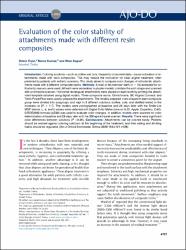Evaluation of the color stability of attachments made with different resin composites
Künye
Erçin Ö, Kurnaz M, Kopuz D. Evaluation of the color stability of attachments made with different resin composites (2023). American Journal of Orthodontics and Dentofacial Orthopedics. 164(4); e121-e128.Özet
Introduction: Coloring solutions—such as coffee and cola, frequently consumed daily—cause coloration of at tachments made with resin composites. This may reduce the motivation for clear aligner treatment, often
preferred by patients with esthetic concerns. This study aimed to compare color changes of orthodontic attach ments made with 3 different composite resins. Methods: A total of 90 premolar teeth (n 5 10) extracted for or thodontic reasons were used. All teeth were embedded in plaster models to imitate the arch shape and scanned
with an intraoral scanner. Horizontal rectangular attachments were placed on each tooth by printing the attach ment template obtained using digital models. Three composite resins: Omnichroma, GC Aligner Connect, and
Tetric PowerFlow were used to prepare the attachments. The models prepared in arc-shaped in each composite
group were divided into subgroups and kept in 3 different solutions (coffee, cola, and distilled water) in the
incubator at 37 6 1 C. The models were photographed at baseline and 28 days later with the Smile-Lite
MDP device. L, a, and b values were obtained with Digital Color Meter (version 5.22; Apple, Cupertino, Calif).
CIEDE2000 formula (DE00) was used to evaluate color changes. In addition, models were scanned for color
determination at baseline and 28 days later with the 3Shape intraoral scanner. Results: There were significant
color differences between solutions (P \0.05). Conclusions: Attachments can be colored easily. Patients
should be warned against coloring solutions at the beginning of the treatment, and their eating and drinking
habits should be regulated.
Kaynak
American Journal of Orthodontics and Dentofacial OrthopedicsCilt
164Sayı
4Bağlantı
https://doi.org/10.1016/j.ajodo.2023.07.008https://www.sciencedirect.com/science/article/pii/S0889540623004006?via%3Dihub
https://hdl.handle.net/20.500.12780/736


















